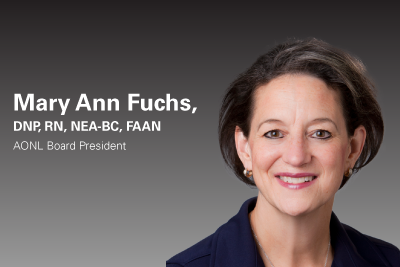
Voice of the President | September 2021
The coronavirus pandemic has taught us many valuable lessons. One that I believe will be integral to the growth and sustainability of the entire health care workforce is just how deeply mental and physical health are impacted by the work that we do every day and how important it is to cultivate workplaces that foster well-being.

Research tells us that the well-being of front-line clinicians is fundamental to our ability to provide safe, high-quality care. In 2019, a National Academy of Medicine report estimated that one-third to one-half of health professionals were experiencing burnout, based on current studies. In the summer of 2020, a survey of more than 1,000 health care workers by Mental Health America indicated that across all health professionals, 76% reported feelings of burnout and exhaustion because of the pandemic. The survey showed nurses were particularly vulnerable, reporting higher levels of exposure risk to the virus, greater exhaustion and inadequate access to emotional support resources. As a result, we continue to see higher than normal turnover, transfers of inpatient staff to lower acuity levels of care and nurses exiting the profession altogether. Trauma-informed care literature tells us that the consequences of disasters and traumatic events can have lasting impact on our health, so I am encouraged to see the sustained efforts of so many national organizations—as well as many of the nation’s hospitals and health systems—focused on addressing this issue.
In my own health system, caring for each other is a core value, one we take very seriously.
In the past 18 months, many organizations, including your own, have likely implemented some kind of initiative to begin to address the well-being of the workforce. In my own health system, caring for each other is a core value, one we take very seriously. Like other health systems and hospitals, we experienced the triple challenges of managing through the unknown, implementing programming to address systematic racism in our organizations and caring for a very stressed community that brought previously unseen levels of workplace violence to our doors. We accelerated and implemented a number of efforts to ensure that we were living this value. One such effort that I am particularly proud of is the integration of fostering joy in work into our health system strategic plan. This foundational portion of our plan includes a focus on cultivating an environment that is inclusive, diverse and committed to delivering excellent patient care. In addition to broad recognition campaigns, each of our entities and schools facilitated open discussions with historically underrepresented colleagues and completed an extensive analysis of hiring and promotion practices to better understand and address areas of opportunity. Our goal is to focus on growing and supporting the workforce in all facets of well-being, enabling staff to reach their full potential.
One of my lessons learned through the pandemic experience is that no one-size-fits-all solution can address the well-being of a diverse team. It is important is to ensure that well-being efforts are systematic and intentionally integrated into strategy and operations to ensure that resources are available to the staff who need it most.
It has been truly amazing to witness the transformational leadership across our country these past 18 months. With so much change thrust upon us, it is important to reflect on the elements that led to success during our pandemic response. These reflections can help us better plan and prepare for the future. With that in mind, this issue of the Voice of Nursing Leadership focuses on lessons learned from AONL colleagues across the country.
Consistent with the thread of well-being, AONL interviewed Michael Vaccaro, senior vice-president of acute care nursing at Novant Health to discuss organizational initiatives designed to support and address resilience in the workforce. Strengthening internal communications and a staffing app were just two effective efforts that Novant Health will continue beyond the pandemic.
Katherine Haddix-Hill discusses the acceleration of a centralized bed placement program that helped streamline bed placement and keep much needed intensive care unit (ICU) beds open. She shares several cultural, operational and technical lessons learned as she recounts the implementation process.
Many of you likely served in your organization’s command center at some point during the pandemic. Marie Prothero discusses the importance of the nurse executive role in the incident command center and the key insights nurse leaders provide to ensure operational success of the incident response.
Cynthia O’Neal and Sara Gill, nursing school deans at University of Texas San Antonio, outline takeaways from pivoting to simulation and other educational tools for nursing students needing clinical experiences during the pandemic. As their students’ exam results show, these innovative teaching methods were effective.
In times of national, and in this case, international health crises, the value of the nursing profession is underscored. We are there to provide the highest-quality care for our communities. As we move forward to build a more equitable health care delivery system, we must prioritize caring for our colleagues and ourselves.


